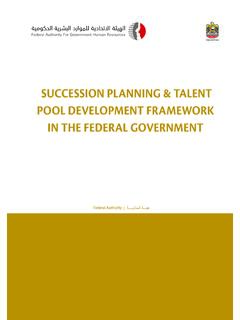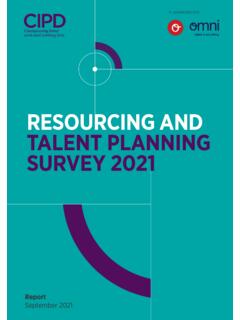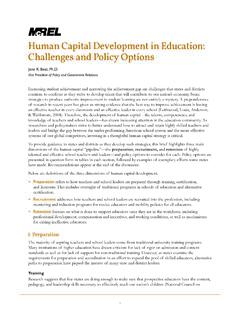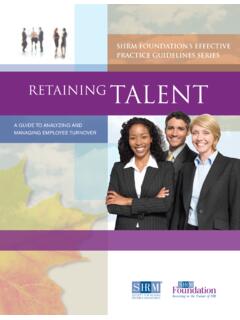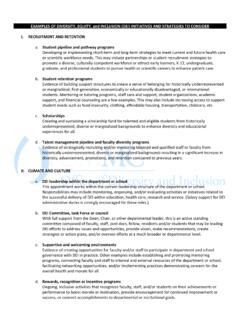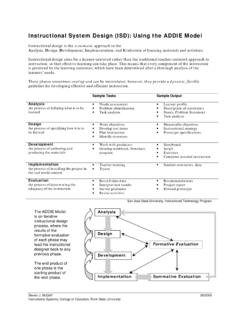Transcription of Talent Review and Development Process : A Step-by-Step …
1 Talent Review and Development Process : A Step-by-Step Guide Context and introduction Developing leadership in the home office is one of the most important and valuable things you do as an organization. These central leadership roles are essential for supporting and improving our schools and ensuring students achieve outstanding outcomes. The network depends on each person in the home office working effectively and passionately. Investing in leadership Development not only builds your collective skills, but also helps you avoid the challenges of staff turnover and external hiring.
2 Considering the value created and costs averted, this investment in your current and future leaders can yield an impressive return. Each person in the home office has a role to play in strengthening our leadership pipeline. While leadership Development should be happening in some form all the time, this guide focuses on the formal processes that orient year-round activities to develop and retain staff. This formal Process , which should take place once a year, is known as the Talent Review and Development Process . To complete the Process , you will fill out individualized assessments for each direct report and an individualized Development plan that includes specific actions to support on the job training, coaching, formal training, and specific retention strategies ( , shifts to compensation, career advancement, and non-monetary rewards).
3 Individual assessment template Development plan template This guide will walk you through the key phases of the Talent Review and Development Process and the steps that you can take in each phase to ensure a high-quality Development experience for your direct reports. 2 Our Talent Review and Development Process is based on six best practices in leadership Development : BEST PRACTICES GUIDING THIS Process EXPLANATION Defined, role-specific competencies A set of shared competencies for hiring, performance evaluations, and professional Development . Ensures that Development areas are not arbitrary, but are aligned to the functional role and/or necessary leadership skills of the employee.
4 Development plans anchored in on-the-job stretch opportunities The Center for Creative Leadership pioneered the 70-20-10 approach, which has three times more impact on employee performance. Focuses 70% of Development on on-the-job training, 20% on coaching and mentoring, and 10% on formal training and self-study. Co-creation/Joint Accountability Both the manager and the employee invested in the design and creation of the plan leads to higher engagement, higher job satisfaction, and an increased likelihood of follow through. Clear measures of Success Measures of success are clear, measurable goals that will be reached once the professional Development plan is complete ( readiness to take on a new responsibility, a new direct report, etc.)
5 Two types of success measures are key: outcomes based measures and Process based measures ( check in once a month around lessons learned, etc.) Regular reflection and updating In order to build habit and make this a priority, progress checkpoints must happen consistently throughout the implementation of the plan. Ensures accountability and allows for problem solving, coaching, and feedback. Connection to year-end evaluation Ensures that Development areas not arbitrary, but are aligned to the organizations strategic priorities and the priorities for this specific role.
6 Connecting the plan to the qualitative and quantitative metrics used to assess performance of employee allows for increased focus, investment, and follow through. 3 Key phases of the Talent Review and Development Process 1. Individual Assessment: Using objective criteria, assess your direct reports demonstrated job performance and demonstrated leadership potential to form a holistic view of how well they are positioned for future leadership opportunities 2. Management Team Calibration: Discuss individual assessments with colleagues to ensure consistent and fair application of performance and leadership potential criteria, to identify themes in Development needs, and to coordinate retention investments 3.
7 Individual Development and Retention Planning: Translate your assessment into a tailored Development and retention plan for each direct report, anchored in on-the-job stretch opportunities and learning 4. Implementation and monitoring: Begin with a conversation with your direct report to share your assessment and Development plan, and collaboratively outline the next steps you will both take to implement and track progress against the Development plan 4 Phase 1: Individual Assessment Many organizations in the education field face challenges in identifying and developing their future leaders, filling roles on an ad-hoc basis.
8 To move toward a more robust leadership pipeline in the organization, it is critical to have a rigorous approach for each individual on staff not just in terms of their performance today, but also in terms of their potential to take on greater leadership responsibility in the future. During the first phase of the Talent Review and Development Process , you will be asked to evaluate a set of direct reports in terms of both their current performance and leadership potential. This evaluation will help you locate your direct reports on the Performance/Potential Matrix, a tool that can inform the individualized Development plans that you create in phase two of the Talent Review and Development Process .
9 There are two dimensions to the matrix: Demonstrated job performance: This axis measures the extent to which an individual is meeting expectations in demonstrating function-specific competencies and accomplishing the tasks and responsibilities that are core to their job description. Demonstrated leadership competencies: This axis measures the extent to which an individual is demonstrating the qualities that would make her or him an excellent and inspiring strategic leader in the organization Assessments on these two dimensions will help you place each of your direct reports in one of the segments of the Performance/Potential Matrix, shown at right.
10 An individual s placement on the matrix translates directly to an over-arching Development goal. The Talent Review and Development Process is intended to provide an objective set of criteria on both of these dimensions performance and potential in order to assess staff members and share consistent expectation across teams, functional groups, and levels within a functional group. These criteria build on the Blueprint for Success Competency Maps developed by EdFuel and Bridgespan. These competency maps provide a comprehensive view of the competencies required for various home or central office roles by function.

